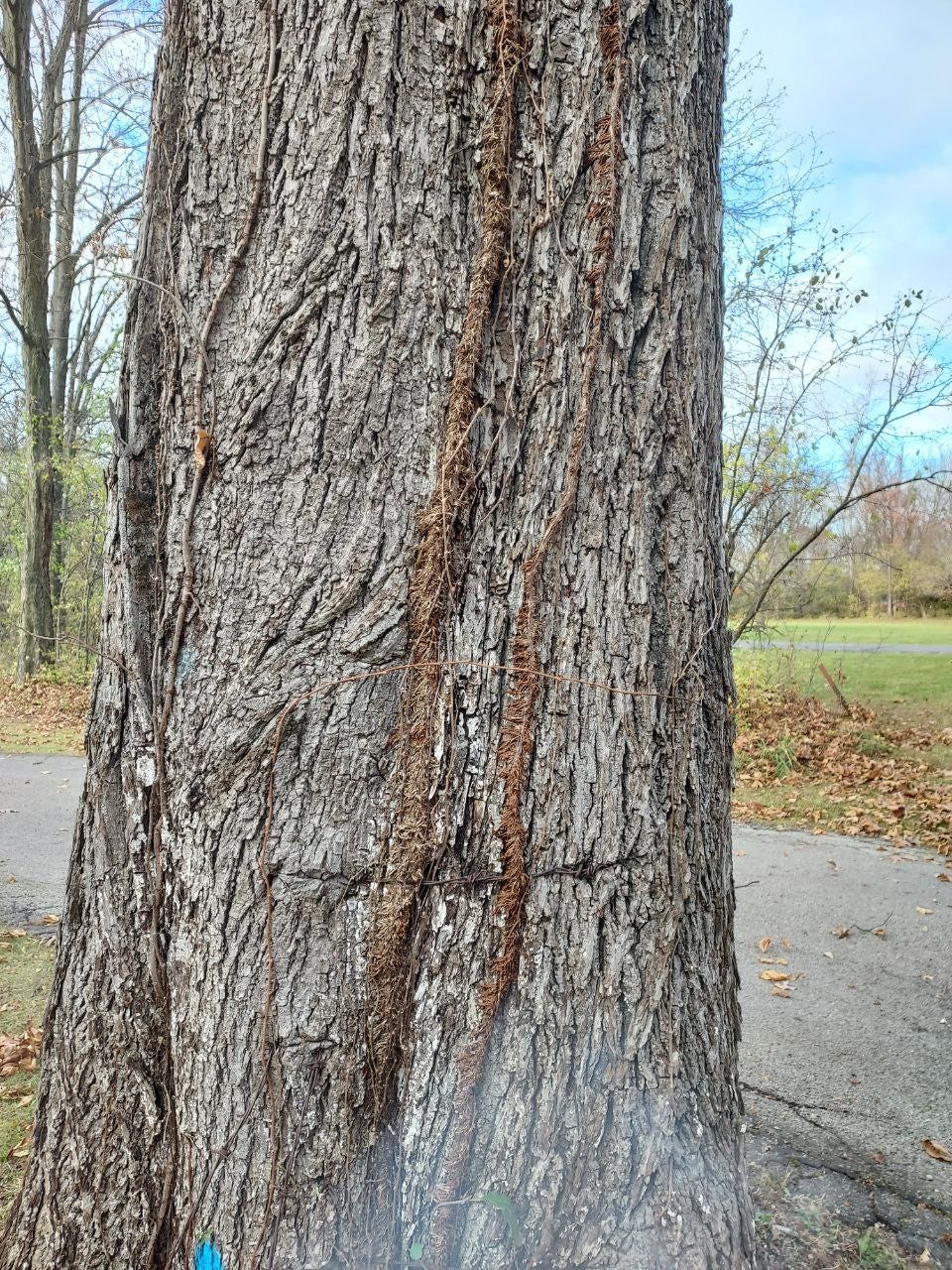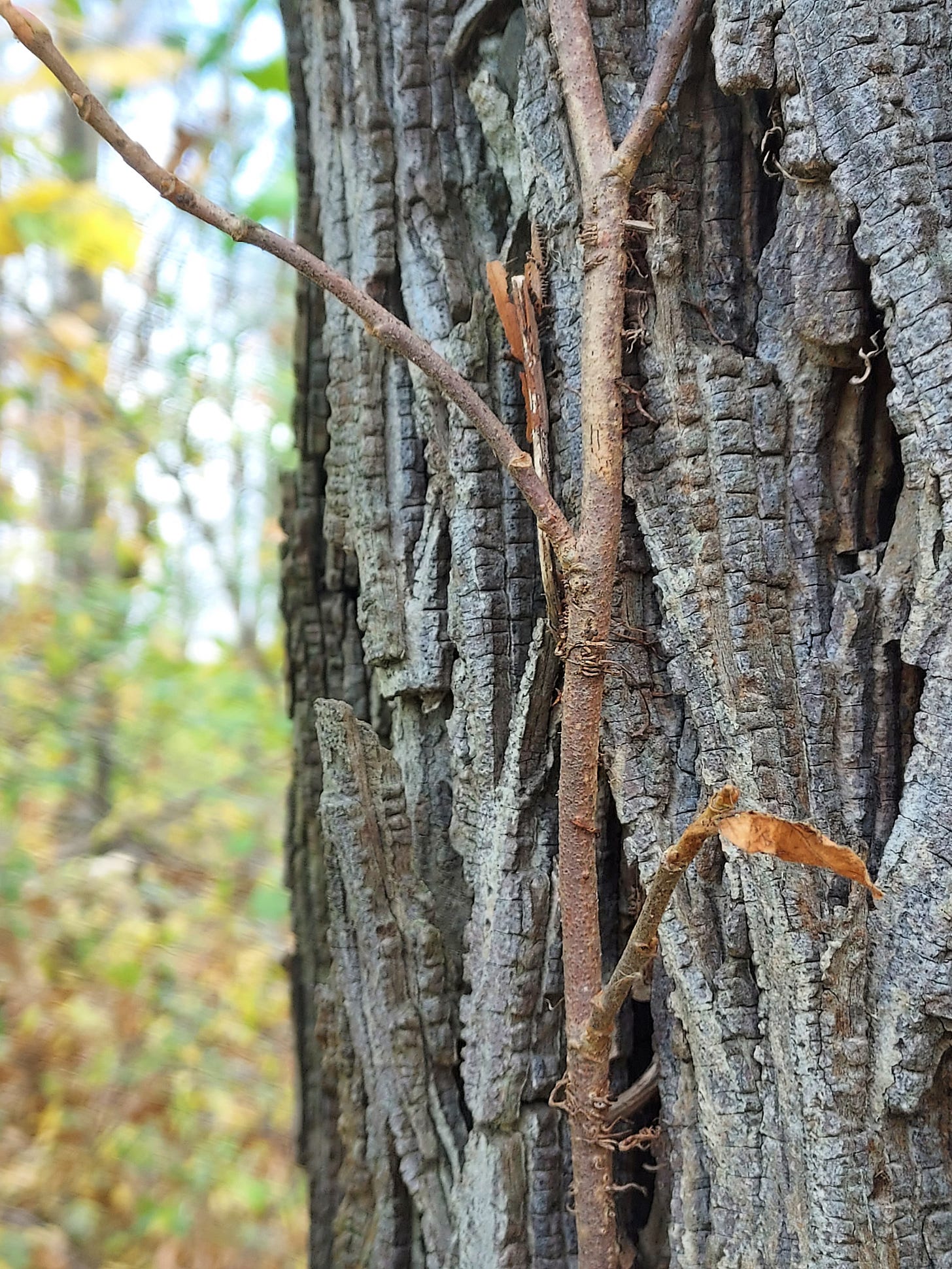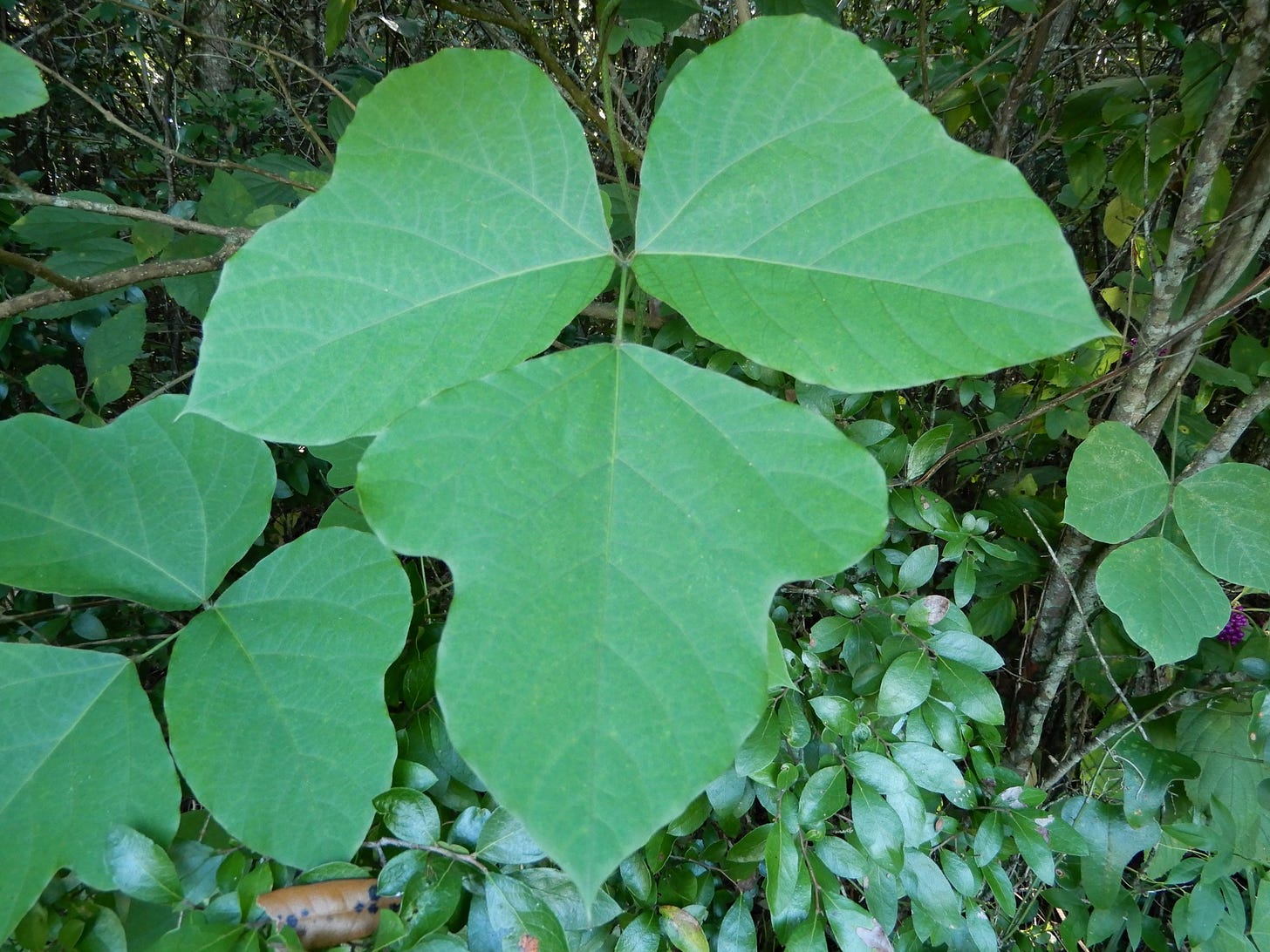Kudzu isoflavones for benzodiazepine withdrawal, or alcoholism, or opiates.
- a revisit of the situationally ironic situation. Also: poison ivy identification (looks like kudzu, but don't touch, or eat) and Moong dal isoflavones are good for us too.
A couple of comments in the replies (thanks!) led to some thoughts before I get back to the super duper long draft post (let’s call it a book summary)… part two - Kudzu - thanks The Mentalist, for your comment.
*post too long for email, but it includes a really tall tree, so I think that’s fair.

Topic two - is situational irony -
Kudzu is a TCM for alcoholism and is invasively covering the southern parts of the US.
a) Large portions of the US are covered with an herb used in Traditional Chinese Medicinal to treat alcoholism. The plant may also be useful to help withdraw from benzodiazepine (BZD) or opiates. The plant, kudzu, is growing invasively and is choking out other plants.
b) Urban areas throughout the US are currently plagued with drug abuse and deaths caused by street drugs (tranq and fentanyl are examples) and/or abuse of prescription drugs like benzo’s (BZD). Alcohol abuse is also a common problem throughout the nation.
c) Hunger and lack of fresh produce are also problems in many urban areas.
d) Kudzu has edible leaves (cooked greens), edible roots (cooked potato style) and edible flowers (scent of grapes, may be made into a sweetened jelly or jam).
e) The government is not subsidizing the harvesting and food processing of kudzu for use in areas with large homeless, drug using populations, or for use anywhere… instead, glyphosate or other herbicides may be used to try to kill it - wrecking the ecosystem further. Also. glyphosate isn’t that effective against kudzu anyway. Digging it up would be more effective at invasive plant control. (Brave AI summary/kudzu & glyphosate)
f) It would make more sense to eat the edible plant with its anti-alcoholism benefits…..than to ineffectively poison the landscape in an effort to kill an edible plant that has medicinal benefits … and is an invasive vine that just is not going to die readily.
g) This is a small business opportunity to start harvesting kudzu and making it into a food for local sales or for commercial sale across the nation. It would be work - including aspects of farming-harvesting and of food processing. The vines or roots would have to be physically cut or dug and then processed into an edible food before it rots, and then the food would need to packaged and stored in a shelf stable way or in a freezer or sold as fresh food for immediate consumption at a special event, or at a Bed & Breakfast, deli, or restaurant.
Viewing from typical business standards - not all the work would be one person. A team of small businesses could work together - one focusing on gathering the raw product at the different seasons; one focusing on processing the food into fresh or shelf stable products; one focusing on retail sales; etc.. On a smaller scale, one person or family might process small amounts of kudzu they harvest themselves, and sell at a farm market or an onsite restaurant of some sort.

Gathering kudzu - beware a Poison Ivy patch.
The leaves are similar looking and both can be vines growing up a tree trunk, but poison ivy grows straight up the trunk while kudzu vines spiral around the trunk.

The kudzu vines are also hairy feeling while poison ivy vines are smooth and woody - poison ivy vine looks like a tree stem and branches and old ones can grow upright like a mini tree or shrub.

For basics on gathering and food prep of kudzu, see: Eat Kudzu (WikiHow).

Kudzu vines have a pretty purple flower cluster in the spring that hangs beneath the leaves and doesn’t show from the roadside.
Kudzu flowers have a grape like aroma and are edible fresh in a salad or made into a jelly or jam.
The kudzu leaves may be used raw but seem to be more typically cooked like steamed or deep-fried greens. The new leaves in the spring are likely more tender.

The roots might be roasted like potatoes or dried and made into a powder which might be sold as a capsule health product, or as a food starch to thicken sauces with.
Kudzu root flakes are available from Eden Foods brand, $13.29 for 3.5 oz dried, (vitacost.com) → currently a high-priced specialty item with a limited health food market in the US.
Kudzu root is available as a food starch for Japanese markets, (Flours/Baking), $14.98 for 150 gram (which is not much at all ~ 5 ounces), (japanesetaste.com).
—> There is money to be made in the vines that are choking out native species all over the southern states of the US. And increased use in cooking could also help reduce alcohol or other addictions as a side bonus and reduce inflammation in general.

Poison Ivy 101 (Toxicodendron radicans):
*If you do wander into a Poison Ivy patch, go wash thoroughly with soap ASAP - including all clothing worn in the patch. The rash develops by touching the plant and getting sap on you called urushiol. It can be allergy inducing and is an oily substance that needs lots of soap to wash off. The longer it stays on you, the more it may irritate, unless you can quickly wash it off with soap, plenty of soap, lots of soap. The soap is a key point.
The plant sap is oily, containing phenolic lipids, so it needs more than a water rinse to remove. The prompt washing can help prevent the irritation from developing into a rash - which is damaged tissue due to the increase in inflammatory signaling causing white blood cells to flood the area along with increased fluid, causing swelling and pain.
“The rash – which usually ends with nasty blisters – starts a day or so after someone has been exposed to urushiol, and can persist for two miserable weeks or more.” Magnificent Molecules - Urushiol, (edu.rsc.org)
Mango has some urushiol on its plant and peel, but not within the fruit interior. Urushiol is also produced by a tree, and the oily sap is collected and made into a prized type of varnish in Japan. (edu.rsc.org)
The sap contains a variety of chemical phenols called catechols, attached to varying length chains of fatty acids - lipids - which provide the oily residue that needs lots of soap to wash off the sap. The sap may rub off from any part of the plant - roots, bark, branches, leaves, flowers or berries. (healthline.com)
“Chemically speaking, the molecules in urushiol are known as catechols. They’re based on a ring of six carbon atoms, [*the polyphenol/benzene ring] with alcohol groups attached to two of them and then a string of hydrocarbons [*the fatty acid/lipid part] trailing off another. They are produced by a number of different plant species – most notably those in the Toxicodendron genus, including the Chinese lacquer tree, poison oak and poison sumac. [*and poison ivy vine] (edu.rsc.org)
Polyphenols! …the topic of the last post.
Catechols are flavonoids and would be classified as:
Phenolic compounds: due to the presence of a phenolic hydroxyl group (-OH)
Polyphenols: due to the presence of multiple phenolic rings
Catecholic compounds: specifically, due to the presence of a 1,2-dihydroxybenzene ring (catechol structure). (Brave AI summary/catechols)
Catechols are important in physiology because they make up the backbone structure of dopamine and norepinephrine/noradrenalin, both catecholamines. Catechins can be made into catechols by beneficial gut microbiome species. (ScienceDirect/catechol) Dietary catechins are a type of flavonoid included in the recent dietary recommendation for 400-600 mg/day of flavanols. (Crowe-White, et al, 2022) Catechins are found in green or black tea, pomegranate peel, red raspberries, goji berries, sumac powder, as some examples.
Things to know about poison ivy rash (that your older brother may not tell you):- poison ivy rash is not communicable. It is an allergy reaction. Your older brother cannot give it to you by rubbing his rash on your arm. But if he rubbed the plant and then rubbed your arm, that might spread the oily irritants onto your skin too — go wash with lots of soap and water.
“Urushiol, the oily, sappy substance which causes an allergic reaction and rash, can stay on clothing and other surfaces for two years or longer unless it’s washed away.
— How to Identify Poison Ivy, (healthline.com).
** I grew up around a lot of poison ivy but no kudzu. I’m too far north for kudzu which is a tropical vine that had been planted on purpose for erosion control - and it grew out of control. Similar story to buckthorn shrubs, but kudzu is edible and buckthorn isn’t. Buckthorn is also used medicinally on a very limited basis - clear out the digestive tract, but … too potent so it is not edible. Berries that look edible, but goes right through the animal is a way to spread seeds farther.
Health benefits of kudzu are attributed to its isoflavone content (a flavonoid polyphenol) - similar to phytonutrients found in soy and Mung beans (aka Moong dal).
“Kudzu, a plant native to Asia, has been used in traditional medicine for centuries to treat various health conditions, including inflammation. The anti-inflammatory properties of kudzu are attributed to its isoflavone compounds, particularly tectorigenin, daidzein, and puerarin.” …
In vitro studies: Kudzu extracts have demonstrated anti-inflammatory activity by inhibiting prostaglandin E2 (PGE2) and tumor necrosis factor-alpha (TNF-α) release, both of which are involved in inflammatory processes (1).
Animal studies: Puerarin, a key isoflavone in kudzu, has been shown to alleviate chronic alcoholic liver injury by inhibiting endotoxin gut-leakage, activating Kupffer cells, and expressing lipopolysaccharide receptors (2).
Human studies: A small case study found that isoorientin, a compound isolated from kudzu root, increased antioxidant levels and reduced inflammation in mice with swollen paws (3). Another study suggested that kudzu root may help regulate blood sugar levels and reduce inflammation in patients with type 2 diabetes (4).
Traditional use: In traditional Chinese medicine, kudzu is used to treat conditions such as arthritis, gout, and other inflammatory disorders. Its anti-inflammatory properties are believed to contribute to its therapeutic effects.” (Brave AI summary/anti-inflammatory benefits of kudzu).
Kudzu reduces inflammation by inhibiting TNF-a and prostaglandin E2. May be helpful for perimenopause and menopause.
(1) “Anti-inflammatory properties [of kudzu] are attributed to decreased prostaglandin E2 and tumor necrosis factor-alpha (TNF-alpha) release, both of which are involved in inflammatory processes (3). The isoflavone tectorigenin demonstrated antiproliferative activity via cell differentiation and reduced expression of Bcl-2, an antiapoptotic protein (1). In animal studies, peurarin may alleviate chronic alcoholic liver injury via **inhibition of endotoxin gut-leakage** [this would be helpful during chimeric spike era], activation of Kupffer cells, and expression of lipopolysaccharide receptors (22).
—> In humans, benefits from kudzu on hot flashes, night sweats, and cognitive function are also attributed to isoflavones (5) (6). Puerarin particularly has been credited with influencing alcohol consumption patterns, although the mechanism by which this might occur is unknown (19).” (Mechanism of Action; mskcc.org/cancer-care//kudzu)
(2) - On Dr. Axe’s site we learn that kudzu may help digestive symptoms too. (draxe.com/nutrition/kudzu-root/)
(3) Precautions -While kudzu is generally safe and well-tolerated as a food or supplement (dried powdered root is sold as a supplement or as a food starch to use in sauces or pudding), use of kudzu may worsen liver disease or estrogen sensitive cancers or conditions. May have blood thinning effects - avoid if also taking an anti-clotting medication. Unknown whether safe during pregnancy and lactation. (webmd.com//kudzu)
See this post: Kudzu, an invasive but medicinal plant, . . . Benzodiazepine withdrawal Syndrome -> histamine excess, Pomegranate, St. John's Wort, Kudzu & BDNF. Mother Nature has solutions for us. Some of them grow invasively, many in fact, of the medicinal herbs/foods, are easy to grow plants that are invasive in many areas. (denutrients.substack)
Polyphenol / Flavonoid / Isoflavone / daidzein, genistein, curcumin, tectorigenin and puerarin.
Isoflavones: Daidzein (*an isoflavone with estrogen-like effects similar to genistein, found in soy or mung beans, (Singh, et al, 2023), and … Kudzu; Genistein (*phytoestrogen in soy); Curcumin, (*in turmeric root). Kudzu has the daidzein, and adds two more isoflavones: tectorigenin, and puerarin.
Puerarin may help reduce alcohol consumption and protect against liver injury. (Mechanism of Action; mskcc.org/cancer-care//kudzu)
Mung beans are also known as Moong dal/lentils.
Moong dal taste great as a sprouted legume or as a bean soup. The flavor is unique to Moong lentils and worth checking out. They are also available peeled and split like split peas, but the peels are a very potent medicinal food and supports the beneficial gut microbiome species. (Sehrawat, et al., 2023) Moong bean extract is even sold as a health capsule type of product. But why not just presoak, cook, and eat the lentils whole? Or sprout them for even more nutrition bang for your grocery buck ($).
Example product (no affiliation) Whole Moong dal for cooking or sprouting “Rani Moong Whole (Ideal for cooking & sprouting, Whole Mung Beans with skin) Indian Lentils, 64oz (4lbs) 1.81kg ~ All Natural | NON-GMO | Kosher | Vegan | Indian Origin”, (walmart.com)
“Mung bean is an important nutritious legume, and known for providing various health benefits due to various bioactive phytochemicals and easily digestible proteins. Regular intake of mung bean helps to regulate metabolism by affecting the growth and survival of good microbes in the host gut. Mung bean has also been reported to have anti-inflammatory, antioxidant, antiproliferative, and immunomodulatory properties.” (Sehrawat, et al., 2023)
Moong dal are among the legumes with less of the negative anti-nutrients found in many types of beans.
This post has more information about which legumes have fewer negative lectins or saponins. (denutrients.substack) The image in the post is of raw moong dal. They are a small round legume. Time saver “Which beans might be better for gut health? Answer: Round ones like black eyed peas, moong dal & red lentils, adzuki, lima beans, and garbanzos, also lupini.”
… Except not soybeans, even though they are round.
All of the legumes that are kidney bean shaped, but various colors, are actually all the same species of legume and they all share a greater concentration of the negative lectins or other chemicals that can harm our gut.
Presoaking beans, nuts, seeds and grains, over-night with some alkali or vinegar, and then rinsing thoroughly can reduce the phytic acid but other anti-nutrients would remain. Traditionally made tofu has less phytic acid than the whole soybeans have - which is very concentrated and a health negative.
Grains, Seeds, Beans - their lectins & our leaky guts.
Cross referencing the table of Saponin content in the book The Paleo Answer by Loren Cordain, (Thrift Books), with the list of beans that are higher in worse lectins, we arrive at Moong beans and black-eyed peas as clear winners. And tofu is far superior to soybeans which don't make it into the use-at-all list. Avoid non-fermented soybean products inclu…
Disclaimer: This information is being provided for educational purposes within the guidelines of Fair Use and is not intended to provide individual health guidance.
Reference List
(Sehrawat, et al., 2023) Sehrawat N, Yadav M, Kumar S, Devi A, Singh R, Sharma V, Dhama K, Lorenzo JM, Sharma AK. Mung bean as a potent emerging functional food having anticancer therapeutic potential: Mechanistic insight and recent updates. Biotechnol Appl Biochem. 2023 Dec;70(6):2002-2016. doi: 10.1002/bab.2505. Epub 2023 Aug 13. PMID: 37574464. https://iubmb.onlinelibrary.wiley.com/doi/10.1002/bab.2505









Very interesting Jennifer. Too far north (Wi) for kudzu I think. Quite interesting about the beans too. I’ll have to try some mung beans. Thanks for the info! 🙏💖